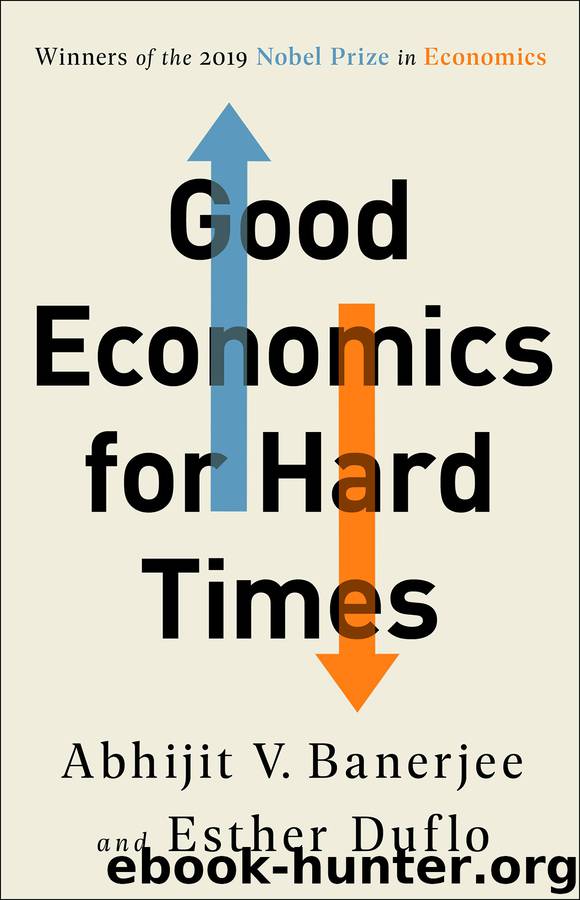Good Economics for Hard Times by Abhijit V. Banerjee & Esther Duflo

Author:Abhijit V. Banerjee & Esther Duflo
Language: eng
Format: epub
Publisher: PublicAffairs
Published: 2019-11-11T16:00:00+00:00
EVERYONE WAS RIGHT, EVERYONE WAS WRONG
Where does all of this leave us in our understanding of economic growth? Well, Robert Solow was right. Growth seems to slow down as countries get to a certain level of per capita income. At the technological frontier, that is to say in the rich countries, TFP growth is largely a mystery. We do not know what propels it.
And Robert Lucas and Paul Romer were right too. For the poorer countries, convergence is not automatic. This is probably not mainly because of spillovers. It is more that TFP is much lower in poorer countries, to a significant extent because of market failures. And therefore to the extent that business-friendly institutions have something to do with fixing market failures, Acemoglu, Johnson, and Robinson were right too.
And yet all of these economists were also wrong, because they thought of economic growth and of a country’s resources as aggregate things (the “labor force,” the “capital,” the “GDP”), and in doing so they probably missed the key point. Everything we have learned about misallocation tells us we have to step beyond the models and think of how the resources are used. If a country starts by using its resources very badly, like China did under communism or India did in its days of extreme dirigisme, then the first benefits of reform may come from moving resources to their best uses. Perhaps the reason why some countries, like China, can grow so fast for so long is that they start with a lot of poorly used talent and resources that can then be harnessed. This is neither Solow’s nor Romer’s world, in which a country would need either new resources or new ideas to grow. It might also suggest the growth could slow down rapidly, once those wasted resources have all been put to good use, and growth becomes dependent on additional resources. Much is being written about the economic slowdown in China; growth is definitely slowing down and that is probably to be expected. This trend will almost surely continue, whatever Chinese leaders do now. China accumulated resources rapidly, as it had plenty of room to catch up; in the process, the most blatant sources of misallocation were eliminated, which means there is less room to improve now. The Chinese economy relied on exports to provide know-how, investment, and endless (for a while) global demand. But now they are the largest exporter in the world, so they cannot possibly continue to grow their exports much faster than the world is growing. China (and the rest of the world) will have to come to terms with the reality that their era of breathtaking growth is likely coming to an end.
In terms of what is to come, it looks like the United States can relax a bit. In 1979, Harvard professor Ezra Vogel published a book, Japan as Number One, that predicted Japan would soon overtake all other countries to become the number one economic superpower. Western countries, he argued, needed to learn from the Japanese model.
Download
This site does not store any files on its server. We only index and link to content provided by other sites. Please contact the content providers to delete copyright contents if any and email us, we'll remove relevant links or contents immediately.
The Secret History by Donna Tartt(16611)
The Social Justice Warrior Handbook by Lisa De Pasquale(11486)
Thirteen Reasons Why by Jay Asher(7783)
This Is How You Lose Her by Junot Diaz(5755)
Weapons of Math Destruction by Cathy O'Neil(5032)
Zero to One by Peter Thiel(4818)
The Myth of the Strong Leader by Archie Brown(4787)
Promise Me, Dad by Joe Biden(4441)
Stone's Rules by Roger Stone(4413)
Beartown by Fredrik Backman(4406)
How Democracies Die by Steven Levitsky & Daniel Ziblatt(4393)
The Fire Next Time by James Baldwin(4338)
100 Deadly Skills by Clint Emerson(4072)
A Higher Loyalty: Truth, Lies, and Leadership by James Comey(4028)
Rise and Kill First by Ronen Bergman(4009)
The David Icke Guide to the Global Conspiracy (and how to end it) by David Icke(3877)
The Farm by Tom Rob Smith(3870)
Secrecy World by Jake Bernstein(3774)
The Doomsday Machine by Daniel Ellsberg(3726)
